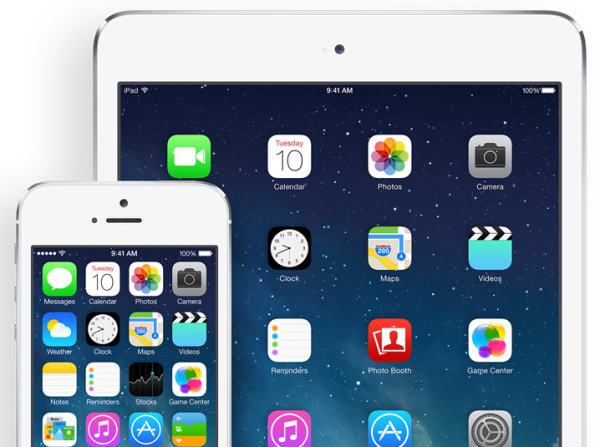Morning After iDay: iPhone 5C, Touch ID And iWork
There was no “iWatch.” There was no Apple TV upgrade. There was no iPad or iPod refresh. However almost everything else about yesterday’s iPhone event was predicted and endlessly discussed prior to the appearance of Tim Cook & Co. on stage yesterday morning in Cupertino — even Touch ID, the new fingerprint biometric password substitute. […]
 There was no “iWatch.” There was no Apple TV upgrade. There was no iPad or iPod refresh.
There was no “iWatch.” There was no Apple TV upgrade. There was no iPad or iPod refresh.
However almost everything else about yesterday’s iPhone event was predicted and endlessly discussed prior to the appearance of Tim Cook & Co. on stage yesterday morning in Cupertino — even Touch ID, the new fingerprint biometric password substitute.
Perhaps the one thing that wasn’t correctly predicted was the pricing of the iPhone 5C. Wall Street Analysts and others had expected a much less expensive device for China and other emerging markets. They didn’t really get it. The unlocked the 5C will start at $549, seemingly too much for people in many in developing countries.
Of course with a subsidy the 5C is in fact less expensive than the 5S: $99 with a contract. We don’t yet know precisely how it will be priced in China.

Apple’s stock traded lower yesterday as the market reflected disappointment over the pricing of the 5C. However analysts have also been concerned, paradoxically, about the preservation of Apple’s margins. The 5C manages to appeal to new audience segments while doing that.
As John Gruber and others have pointed out what’s most interesting (and perhaps surprising) about yesterday’s launch is that the 5C is now the iPhone 5/last-year’s model replacement in Apple’s handset lineup. It’s arguably the new gravitational center of the iPhone universe. Indeed, it’s the 5C and not the 5S that’s being most heavily promoted in the wake of yesterday’s announcements.
Many people will continue to feel disappointed that Apple’s iPhone screens are smaller than most of its Android rivals (although that will change next year). However the new product lineup is distinctive. The 5C doesn’t feel like “last year’s model.” It will be a clear choice for many, not just because of its lower price but because of its colorful shell options.
By comparison the 5S also stands out, partly because of its camera, speed and other specs, but also because of Touch ID. As I’ve argued elsewhere, Touch ID is to the 5S what Siri was to the 4S: a kind of “wow” feature that helps differentiate it from other smartphones.
Touch ID can be used instead of a password to unlock the phone but also to buy things on iTunes, including apps. It’s an innovative, major new feature and will impact competitors who will be compelled to match it (just as Google felt compelled to match Siri).

Siri also got a much-less discussed upgrade, which is part of iOS 7. The voice is more natural sounding and it draws upon more data sources, including Wikipedia, Twitter and Bing for general web search. The Twitter search feature wasn’t previously announced but the others had been discussed earlier this year when iOS 7 was first unveiled.
Siri is now a much more complete substitute for Google on in iOS 7. People will undoubtedly continue to search with Google on the iPhone but at the margins some of that traffic may go to Siri (and Bing).
Another potentially significant announcement yesterday that received little attention is the fact that Apple will now give away its iWork productivity suite for free on the iPhone and iPad. The PC version still costs money but users can access a cloud version for free. In the end Apple may give away the desktop version as well.
The combination of a newly free mobile iWork and Google Drive/Docs will put additional pressure on Microsoft. Office is one of its two cash cows. The company has been slow to release Office for non-Microsoft mobile devices, hoping that would boost hardware/Surface sales. It hasn’t.
Apple CEO Tim Cook started the event yesterday by announcing that the company will soon have activated 700 million iOS devices (including iPad and iPod Touch). Google previously announced that it had activated a billion Android devices. This argues that the market-share gap between the two companies isn’t as stark as many of the figures we see from IDC, Gartner and others suggest.
It remains to be seen how the 5C performs in North America and abroad. I suspect it will be popular. I also suspect that the mindshare and “shelf space” the new iPhones will capture will help ensure that the global smartphone market continues to be largely a two-horse race between Apple and Google (with major help from Samsung).
Contributing authors are invited to create content for MarTech and are chosen for their expertise and contribution to the martech community. Our contributors work under the oversight of the editorial staff and contributions are checked for quality and relevance to our readers. MarTech is owned by Semrush. Contributor was not asked to make any direct or indirect mentions of Semrush. The opinions they express are their own.
Related stories
New on MarTech